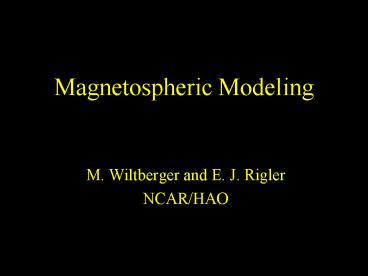Magnetospheric Modeling PowerPoint PPT Presentation
Title: Magnetospheric Modeling
1
Magnetospheric Modeling
- M. Wiltberger and E. J. Rigler
- NCAR/HAO
2
Outline
- What is the magnetosphere?
- How do we model it?
- Possible areas where statistics can help us
3
Solar Origins
- Solar Flares - abrupt release of energy
- localized solar region
- mainly radiation (UV, X-rays,?-rays)
- occur near complex sunspot configurations
- Coronal Mass Ejections (CMEs)
- Releases of massive amounts of solar material
- Usually with higher speeds and greater magnetic
fields than surrounding solar wind - Usually cause shocks in solar wind
- Solar Wind
- Steady ionized gas outflow with average velocity
400 km/s - Magnetic field direction variable
- Exact properties depend upon solar origins
4
Earth's Magnetosphere
- The magnetosphere is region near the Earth where
it's magnetic field forms a protective bubble
which impedes the transfer of energy and momentum
from the solar wind plasma
- A variety of different phenomenon
- Substorms
- impulsive energy release over hours
- Storms
- globally enhanced activity over days
- Radiation belts
- trapped particles which are omnipresent
5
Magnetospheric Currents
- Magnetopause current systems are created by the
force balance between the Earths dipole and the
incoming solar wind
6
Ionospheric Currents
Region 1
Region 2
- FAC from the magnetosphere close though Pedersen
and Hall Currents in the ionosphere
7
LFM Magnetospheric Model
- Uses the ideal MHD equations to model
the interaction between the solar wind,
magnetosphere, and ionosphere - Computational domain
- 30 RE lt x lt -300 RE 100RE for YZ
- Inner radius at 2 RE
- Calculates
- full MHD state vector everywhere within
computational domain - Requires
- Solar wind MHD state vector along outer boundary
- Empirical model for determining energy flux of
precipitating electrons - Cross polar cap potential pattern in high
latitude region which is used to determine
boundary condition on flow
8
Numerics of the LFM
- LFM solves ideal MHD eqs in conservative form
using the Partial Interface Method - PIM is hybrid scheme that balances the competing
diffusion and dispersion errors by selectively
adding diffusion to high order scheme - Limitor keeps solution monotonic
- Provides nonlinear numeric resistivity
9
Computational Grid of the LFM
- Distorted spherical mesh
- Places optimal resolution in regions of a priori
interest - Logically rectangular nature allows for easy code
development - Yee type grid
- Magnetic fluxes on faces
- Electric fields on edges
- Guarantees ??B 0
10
Ionosphere Model
- 2D Electrostatic Model
- ??(?P?H)??J
- ?0 at low latitude boundary of ionosphere
- Conductivity Models
- Solar EUV ionization
- Creates day/night and winter/summer asymmetries
- Auroral Precipitation
- Empirical determination of energetic electron
precipitation
11
Calculation of Particle Fluxes
- Empirical relationships are used to convert MHD
parameters into an average energy and flux of the
precipitating electrons - Initial flux and energy (Fedder et al., 1995)
- Parallel Potential drops (Knight 1972, Chiu
1981) - Effects of geomagnetic field (Orens and Fedder
1978)
12
Determining Energy Flux
- According to Lummerzheim 1997, it is possible
using the UVI instrument on POLAR to determine
both the characteristic energy and energy flux - Energy flux is proportional to emission rates in
the LBH bands - Characteristic energy determines altitude of
emission so it is determined by monitoring
brightness of features that decay away and those
that persist
13
Estimating Optimal Parameters
- LFM electron flux/energy estimates are projected
onto irregular grid corresponding to Polar UVI
observations - 1-D state vector constructed from all available
observations time is simply treated as a third
coordinate, in addition to MLT and ALAT - Levenberg-Marquardt (nonlinear least-squares)
algorithm adjusts model parameters a, b, and R to
minimize the sum of the squared prediction
errors
14
(No Transcript)
15
Can advanced statistics help us?
- Are there better parameter estimation algorithms
then Levenberg-Marquart? - What can statistical comparisons with
observations tell us about the bias present in
our models? - What are the best measures to monitor model
improvement over time?
16
Some Research Problems
- 1. How can uncertain model parameters be
optimized to provide the best agreement, on the
average, with observations? - 2. How can model variability about the average,
including information about scale sizes of this
variability, best be compared with variability in
observations to determine agreement or
disagreement? - 3. How can we improve the interpolation/extrapolat
ion of observations of model input parameters in
space and time to get complete specification of
the boundary conditions? - 4. In developing parameterizations of sub-grid
phenomena, such as the transport of momentum and
the creation of turbulence by breaking gravity
waves, what is a good measure of intermittency,
and how can its effects be parameterized? - 5. How can relatively rare and sparse
observations of extreme events like large
magnetic storms be used to characterize
upper-atmospheric behavior and test simulations
for such events? - 6. What can statistical comparisons tell us about
underlying biases in our models? - 7. What are the best measures to monitor model
improvement over time?
17
(No Transcript)
18
MI Coupling Eqs
- As described in Kelley 1989 The fundamental
equation for MI coupling is obtain by breaking
the ionospheric current into parallel and
perpendicular components and requiring continuity
- Assuming no current flows out the bottom of the
ionosphere we get - Further assuming the electric field is uniform
with height we get - And finally using and electrostatic approximation
in the MI coupling region we obtain
19
Conductances from Particle Flux
- Spiro et al. 1982 used Atmospheric Explorer
observations to determine a set of empirical
relationships between the average electron energy
and the electron energy flux - Robinson et al. 1987 revised the relationships
using Hilat data and careful consideration of
Maxwellian used to determine the average energy

